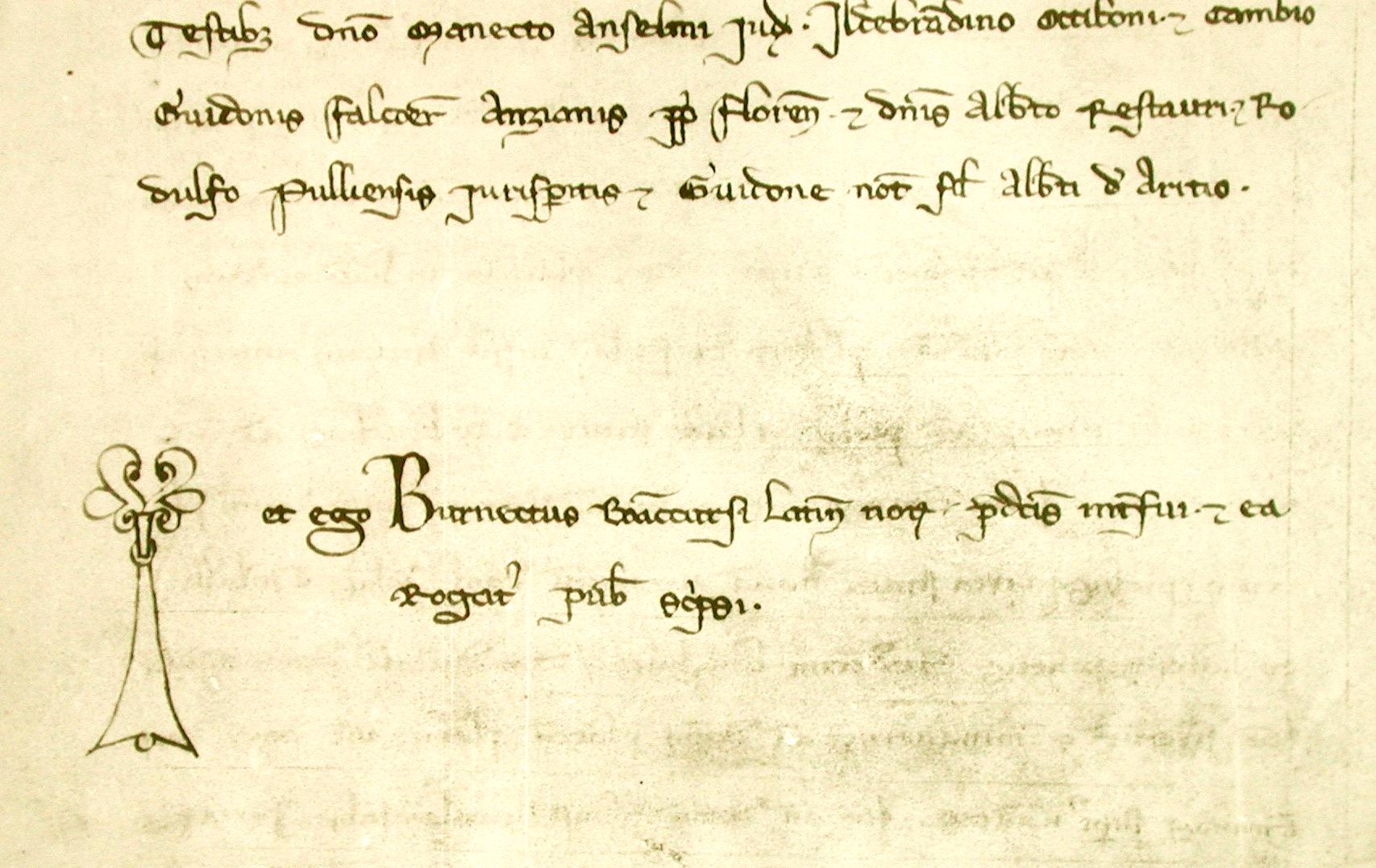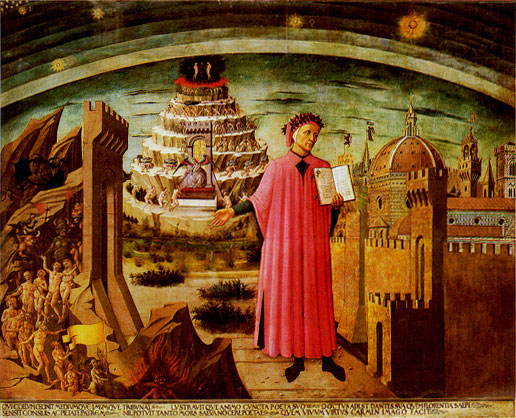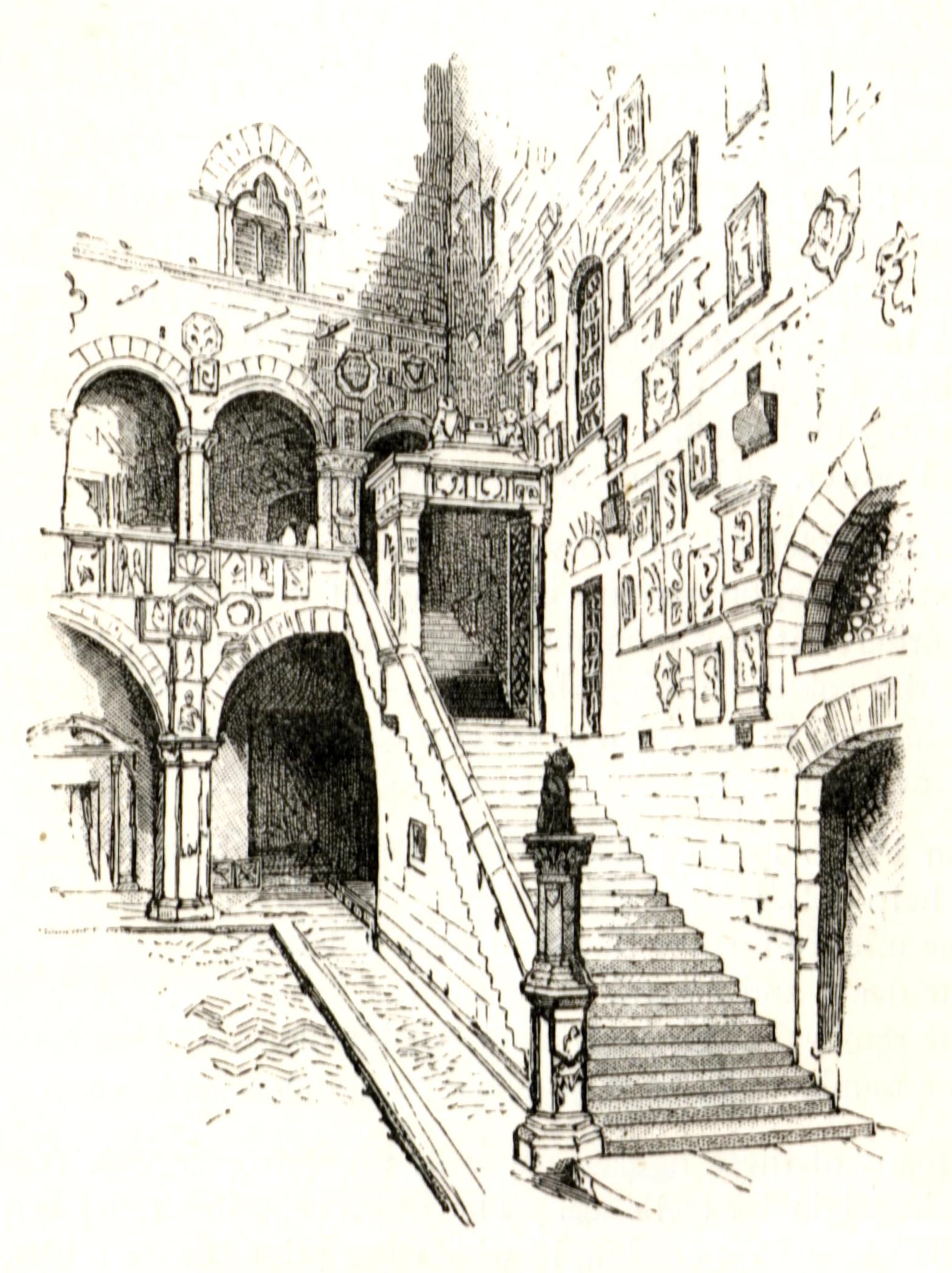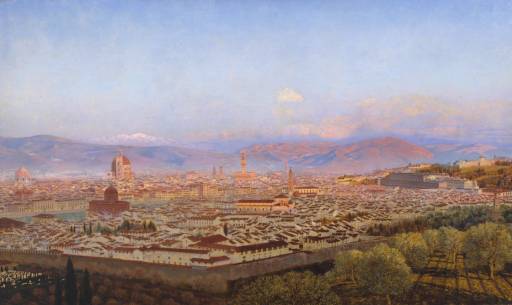


 Dante
Alighieri, Portraits, Florence, Riccardian manuscript
frontispiece; Orvieto, Luca Signorelli fresco
Dante
Alighieri, Portraits, Florence, Riccardian manuscript
frontispiece; Orvieto, Luca Signorelli fresco .jpg)





What the baby Dante would have seen at his Baptism that Easter Saturday, 3 April 1266, much of the mosaic work already in place, though not yet the exterior work in white and green marble. He notes, too, in Paradiso XV.133 that his ancestor, his crusading great grandfather, was also baptized there. The Holy Saturday liturgy included the Psalm 113, In Exitu Israel de Aegypto ♫ (here we hear the Ensemble San Felice sing the psalm, with its unique tonus peregrinus, which Dante spoke of in the Convivio and which he says in the Letter to Can Grande is the entire allegory of the Commedia), where Dante has the 100 pilgrims sing in unison in Purgatorio II after Virgil baptizes him with water and girds or crowns him with a rush, the Red Sea being called Ram Suf, the Sea of Rushes. He dates the Commedia from Good Friday through Easter Week, 1300/actually 1301, and has his baptism reflected twice over in Purgatorio I, when Cato has Virgil baptize him, and again in Purgatorio XXXI, when Matelda drags him through the waters. Dante, when adult, he tells us, once broke one of the side fonts to rescue a drowning child, Inferno XIX.16, a piece of this in the Museo Opera del Duomo.








 At Dante's time
At Dante's time



At the completion of Brunelleschi's dome in 1436, Guillaume Dufay's motet, Nuper Rosarum flores, was sung, evoking, as does the Cathedral's dedication, Santa Maria del Fiore, Dante's Rose. Inside the Duomo on its left wall is this later painting, showing Florence as it became then, painted in 1465 by Domenico di Michelino where Dante preaches to Florence as her prophet, the three gates of Hell, of Purgatory and of Florence, all like those built by Arnolfo da Cambio, while Mount Purgatory is a composite of Fiesole's Monte Ceceri with its galleries mined for pietra serena, a grey porous sandstone (now hidden by the cypresses planted by Victorian Englishmen) and of Mount Sinai, similarly with terraces at which the monks of St Catherine's Monastery heard pilgrims' confessions.


Confession gate on
Sinai
Sinai, David Roberts
5. The Giotto Tower was built
after Dante's exile from Florence.
6. The tomb of
Brunetto Latino, Dante's
teacher, was originally among the tombs that had littered the
Piazza San Giovanni, as described by Boccaccio concering Guido Cavalcante in the Decameron
VI.ix, and by George Eliot in Romola, those of the
members of the Compagnia dei
laudesi of Orsanmichele
being grouped beneath the sculpture of the Annunciation,
formerly on the exterior wall of Santa Reparata, now on the
Duomo wall by the Giotto Tower. Brunetto's Tesoretto
and Tesoro are used by Dante throughout the Commedia,
and these sculptures figure in Purgatorio
X.

Giroldo da Como, Annunciation, for the tombs of the Orsanmichele Compagnia
dei Laudesi that were in the Piazza San Giovanni.


7a. The Bigallo/Misericordia. The Bigallo Museum was originally part of the Misericordia, and its fresco of the Madonna della Misericordia, later than Dante's time, presents the city of Florence and her citizens sheltered under the Madonna's cloak, which in turn is embroidered with the Seven Acts of Mercy. The Libro del Biadaiolo, written for 30. Orsanmichele, now Laurentian Library, Tempe 3, and the Polyptich of Saint Umiltà in the Uffizi also show medieval Florence in Dante's time, while the Domenico di Michelino is painted later when the Duomo of Santa Maria del Fiore was built. See Hare, Florence, Horner, Walks in Florence.

























Maria Grazia Beverini
Del Santo, Piccarda Donati nella storia del Monastero di
Monticelli (Firenze: Pagliai, 2007).














20. Now we turn into the Via del Proconsolo. On our left we come to the Bargello, then the Palace of the Podestà. the hired outsider under contract for a limited term of office (like the American President), who had to swear to uphold and administer the Constitution, the Statutes, bringing with him soldiers, lawyers and judges, with which to administer justice, prevent crime, mend roads and bridges, and care for widows and orphans. This part of the city of Florence with the 20. Bargello, 23. Torre della Castagna, and 40. Palazzo Vecchio, then called the Palazzo del Popolo, is dedicated to its government, the State, rather than the Church, to Justice, complemented by Mercy. See Hare, Florence. Map1D.






ASF, Libro di Montaperti, fol. 33r Vatican Library, L.VIII.296, fol. 92r, Villani, Nuova Cronica, Montaperti
Brunetto Latino. before leaving for Spain, wrote pages in his own hand in the Libro di Montaperti, which is now kept in the Florentine State Archives along with the Libro del Chiodo. The Giovanni Villani, Nuova Cronica, manuscript is illuminated by Pacino di Bonguida who would also illuminate manuscripts of the Commedia for Francesco da Barberino.
3 July 1292 Giano
Della Bella’s Ordinaments of Justice. Miracles
of the Virgin in 30. Orsanmichele’s
tabernacle begin, Guido
Cavalcanti writing about them in his sonnet.
1295 Dante’s membership in the Arte de’ Medici
e Speziali.
15
June-15 August 15 1300, Dante is one of Florence’s
Priors in the 23.
Torre della Castagna,
near 30. Orsanmichele. These Priors,
according to the Ordinaments of Justice, have to exile
Corso Donati and Guido Cavalcanti, who dies in
August of malaria.


Those condemned to death would spend the night before in prayer in this Magdalen Chapel. At the same time Francesco commissioned the tomb by Tino da Camaino for the Bishop Antonio D'Orso in the Duomo. Francesco would carefully rehabilitate Dante's memory in Florence, seeing to it that a hundred manuscripts of the Commedia issued from his Florentine publishing house, two of which he signed himself.








22. Map 2D, Parrini XIV, Tassinari XIV. In Via Dante Alighieri, 1, to your left as you come out of the 21. Badia church. Oral reading 19 ♫

3 July 1292 Giano Della Bella’s
Ordinaments of Justice. Miracles of the Virgin in Orsanmichele’s
tabernacle begin, Guido Cavalcanti
writing about them in his sonnet.
1295 Dante’s membership
in the Arte de’ Medici e Speziali.
15 June-15 August 15
1300, Dante is one of Florence’s Priors in the 23.Torre
della Castagna, near Orsanmichele.
These Priors, according to the Ordinaments of Justice,
have to exile Corso Donati and
Guido Cavalcanti, who dies in
August of malaria.




 Alighieri stemma with wing, tablet
placed above door before fake Dante house built next door.
Alighieri stemma with wing, tablet
placed above door before fake Dante house built next door.















It can be useful to have at hand
a time line concerning these events in connection with
Orsanmichele:
1260-1266 Brunetto Latino goes on
embassy to Alfonso X el Sabio, following writing several
folios and being often named in the Libro di
Montaperti, then is in exile in France. Alfonso X el
Sabio, seeking to be crowned Holy Roman Emperor, sends
Florence a regal copy of Las Cantigas de Santa Maria
with the miracles of the Virgin in a tabernacle (BNCF MS
Banco Rari 20). Brunetto sends him a Second Redaction copy
of Li Livres dou Tresor, now Escorial MS ii.I.3.
1264 Birth of Francesco
da Barberino
1265 Birth of Dante
Alighieri
13 October 1284 The
Tuscan League of Florence, Genoa and Siena, with ser
“Burnectus Latinus” as ambassador, is seemingly allied
against Pisa to please Charles of Anjou, ASF, Capitoli
di Firenze, Reg.43, fols. 34r-37v,
85r-87v.
1284-1288 Pisa,
blockaded and starving, discovers the betrayal of Ugolino
della Gherardesca with Florence, and places Ugolino and
his progeny in prison (Inferno 32.124-139 -
33.1-108; G. Villani, Cronica, VII. civ).
18 March 1289 Ugolino
and his two sons and two grandsons are discovered to have
died of starvation and cannibalism.
22 March 1289, 7
December 1291, 17 July 1292, the Comune of Florence
discusses giving compensation for Count Guelfo, Ugolino’s
sole surviving son for this war crime
3 July 1292 Giani Della
Bella’s Ordinaments of Justice. Miracles of the Virgin in
Orsanmichele’s tabernacle begin, Guido Cavalcanti writing
about them in his sonnet.
1295 Dante’s membership
in the Arte de’ Medici e Speziali.
15 June-15 August 15
1300, Dante is one of Florence’s Priors in the 23.
Torre della Castagna, near
Orsanmichele. These Priors, according to the Ordinaments
of Justice, have to exile Corso
Donati and Guido Cavalcanti,
who dies in consequence of his exile in August of malaria.
1302 The Libro del
Chiodo with the sentences against the White Guelfs
by the Black Guelfs, whose leader is Corso Donati, is kept
in the Podestà’s Palace, near
Orsanmichele. Dante and Francesco are themselves exiled.
Francesco goes to Padua where Giotto is frescoing the
Arena Chapel.
1304 Orsanmichele is
destroyed in a fire, and then rebuilt.
1304-1308
Francesco da Barberino is Notaio to Corso Donati who is elected Podestà
in Treviso. Francesco commissions
the now lost fresco about Justice, Mercy and Conscience
for the Bishop of Treviso’s Palace. It is probably during
this period that Dante begins the Commedia.
1310-1313 Henry
VII of Luxembourg is Holy Roman Emperor. Dante Alighieri
and Francesco da Barberino together write Latin Epistles
to him. Dante composes the De Monarchia.
Manuscripts BML Plut. 89 inf. 41, in Latin, which opens with images
of Pope and Emperor, and the bildercodex BRicc
MS 1538, in Italian, which is richly illuminated by the
“Master of the Paduan Antiphonaries” and the “Master of
the Naples’ Gratian” are finished in 1313. Both
manuscripts contain texts by Brunetto Latino and appear
to be written by Francesco da Barberino.
1313 Francesco da
Barberino is sent on many embassies for Doge Giovanni
Soranzo of Venice and is associated with the Dandalò ducal
family, perhaps copies the First Redaction Li Livres
dou Tresor, Verona, Biblioteca Capitolare MS DVIII,
for them. As “clericus conjugatus”(a married cleric), he
becomes Doctor of Law.
1318 Francesco returns
to Florence with his second wife and his children from
both marriages.
1321 Dante Alighieri’s
death in Ravenna. Francesco da Barberino commissions the
tomb in the Duomo sculpted by Tino
da Camaino for his patron, Bishop Antonio
D’Orso with the figure of Death shooting arrows from
two bows. He seeks to rehabilitate Dante’s memory in
Florence with the Officina of the “Danti del
Cento” that is active until his own death. He perhaps
commissions the Magdalen Chapel
fresco of Brunetto, Corso, Dante and himself.
1321-1335 II Libro
di Biadaiolo notes Orsanmichele’s granary feeds
even Siena and Pisa in time of famine, illustrated by the
“Master of the Dominican Effigies”.
1322-1345
Giovanni Villani’s Cronica nuova, illustrated by
Pacino di Bonaguida.
1337 Orsanmichele is
again rebuilt.
1347 Bernardo Daddi
paints the Madonna and Child, copying the original
version.
1348 Monna Biancia, ser Brunetto Latino’s daughter,
Guido di Filippo da Castiglionchio’s widow, wills a third
of her estate to the Compagnia
dei Laudesi di Orsanmichele.
1350
Dante Alighieri’s daughter, Antonia, now a nun in Ravenna
with the name in religion of “Beatrice”, is given ten gold
florins by Boccaccio from the
Compagnia dei laudesi di Orsanmichele.
1357 Andrea Orcagna’s tabernacle is
constructed for Bernardo Daddi’s painting.
1358 Monna Biancia dies,
Orsanmichele receives her legacy.
1364 The Judge, Pietro Alighieri, Dante's first-born son,
leaves his parents' house in the Piazzetta San Martino to
the Compagnia dei Laudesi di Orsanmichele.
23 June 1367 A manuscript of the Roman de la Rose is sold by the Compagnia dei Laudesi di Orsanmichele for four golden florins.

Laudario della Compagnia dei Laudesi di Orsanmichele



37. Map 3C, Parrini XXIX, Tassinari XXIX. On the PONTE VECCHIO, where was the statue of Mars. On the other side of the river Arno is 'Oltrarno' or 'beyond the Arno'. Oral reading 6 ♫


Dante Gabriel Rossetti, whose father, a great scholar of Dante, was in political exile from Italy in London, painted the scene of Dante painting angels, imagining the 25. Dante House as by the Arno with a view of this bridge.

In the year 1283, in the month of June for the Feast of St John’s Day, the city of Florence being in a good state of happiness, and tranquil and at peace, and of use for the merchants and craftspeople, largely because of the Guelfs who ruled the land, they made in the area of Santa Felicità in the Oltrarno, where were the head and beginner of that house of de’ Rossi with their neighbours, a company and brigata of a thousand men and more, all dressed in white clothing with a lord called Amore. . . . This court lasted for two months and was the most noble and famous that ever was in the city of Florence and in Tuscany. . . . this lasted until 1284 when the conflict began between the people and those with power, between the White and the Black parties.that Amore to be found in Brunetto Latino's Tesoretto, in Dante Alighieri's Vita nova, a copy of which Dante will present to his teacher one Easter day with the accompanying sonnet, "Messer Brunetto, questa pulzeletta", in the Francesco da Barberino's Documenti d'Amore, and in the Canzoniere Palatino. Francesco da Barberino was a fellow student with Dante Alighieri and Guido Cavalcanti of Brunetto Latino.




40. The Palazzo del Popolo, now called the Palazzo Vecchio, was originally the site of the church of San Piero Schieraggio, as it was the custom in Florence to sign Peace Treaties such as that Brunetto Latino wrote between Siena and Florence in 1254,





Purgatorio XIV. 16-18

| To donate to the restoration by Roma of Florence's
formerly abandoned English Cemetery and to its Library
click on our Aureo Anello Associazione's
PayPal button: THANKYOU! |